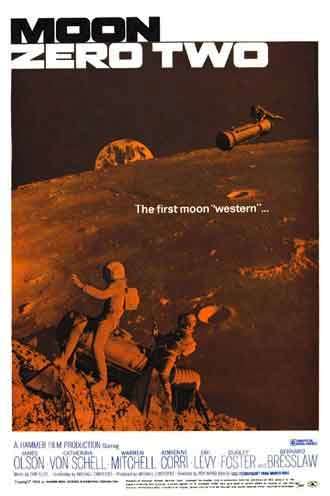Moon Zero Two

Moon Zero Two is a science fiction film produced by Hammer Films and released in 1969. It was billed as a "space western" and made shortly after the release of Stanley Kubrick's 2001: A Space Odyssey. The film did very poorly at the box-office, but became a minor cult classic in following decades.
In the year 2021 the moon is in the process of being colonized, and this new frontier is attracting a diverse group of people to settlements such as Moon City, Farside 5 and others.
Two such denizens of this rough and tumble lunar society are the notorious millionaire J. J. Hubbard and former-astronaut-turned-satellite-salvage-man Bill Kemp. The first man to set foot on Mars, Kemp has now left the Space Corporation because it has abandoned exploration entirely in favour of running commercial passenger flights to Mars and Venus. When Hubbard hears of a small 6000-tonne asteroid made of pure sapphire that is orbiting close to the moon, he hires Kemp to capture it using Kemp's old "Moon 02" space ferry and bring it down on the lunar farside although it would be against the law. However, Kemp has little choice since he has learned that his flight license soon will be revoked due to protests from the Corporation. Hubbard also claims that he plans to use the sapphire as a rocket engine thermal insulator; he would build more powerful rockets capable of finally colonising Mercury, and even the moons of Jupiter, for commercial gain.
Meanwhile a young woman arrives looking for her brother, a miner working a distant patch of moonscape at Spectacle Crater on farside. Unfortunately, the trip from Moon City on the nearside would take six days by lunar buggy. Since Kemp could fly there in twenty minutes in Moon 02, she persuades him to help her learn whether her brother is still alive. In doing so, Kemp learns more than he would like about of Hubbard's schemes and methods.
For the Mystery Science Theater 3000 version, please go to the episode recap page.
- Artificial Gravity: Mostly Moon Zero Two is pretty good at suggesting low-gravity environments using slow-motion, but within base areas artificial gravity is assumed to keep the special-effects budget low.
- Bar Brawl: In low-gravity slow motion.
- Covers Always Lie: Posters for the movie showed rayguns and streamlined spaceships that never appear in the film.
- Disposable Woman: The hero's police-officer girlfriend is bumped off to make room for the Replacement Love Interest.
- High-Class Glass: Hubbard wears a ludicrous tinted monocle.
- Improperly Placed Firearms: It seems that thinly-disguised Revolvers Are Just Better, even on the moon.
- Kinetic Weapons Are Just Better: There's not a Ray Gun in sight.
- Mohs Scale of Science Fiction Hardness: Underneath the silly '60s camp, Moon Zero Two is plenty hard.
- Mundane Dogmatic: Though it was made long before the Mundane Manifesto was published, the film meets the criteria pretty well, if allowance is made for Science Marches On.
- Science Marches On: In many ways:
- The film runs with the "asteroids are the remains of an exploded planet" theory, which modern science has largely discarded.
- The film was made before the Soviet Union's Venera series of unmanned probes revealed just how hostile the surface of Venus is. Colonies? Not any time soon.
- There are ice-mines on the Moon. Science marched away from this idea, but if you hear returning footsteps, it's because of new discoveries.
- Space Clothes: Groovy!
- Space Does Not Work That Way: Despite a fair attempt at realism, there are examples:
- In Space Everyone Can See Your Face: No silly faceplate lights, but no shielding against solar radiation either.
- Space Is Noisy: Mostly averted, but during the gunfight on Farside, gunshots are clearly audible in a vacuum.
- Space Western: The film labelled itself as one, but it more closely resembles the aviation-action thrillers fashionable at the time it was made, and the original story was co-written by Gavin Lyall, a notable author in that genre.
- Spiritual Successor: The television series UFO and Space: 1999 have many stylistic similarities.
- The Stoic: Bill Kemp the hero greets everything with Dull Surprise.
- Used Future: The eponymous spaceship Moon Zero Two is very used.
- Zeerust: The film is a very 1960's vision of the future.